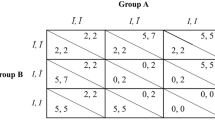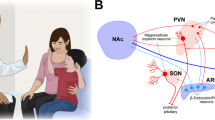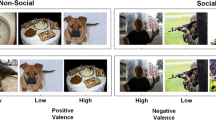Abstract
In an influential paper, Kosfeld et al. (2005) showed that intranasal administration of oxytocin (OT) increases the transfers made by investors in the trust game—suggesting that OT increases trust in strangers. Subsequent studies investigating the role of OT in the trust game found inconclusive effects on the trusting behaviour of investors but these studies deviated from the Kosfeld et al. study in an important way—they did not implement minimal social contact (MSC) between the investors and the trustees in the trust game. Here, we performed a large double-blind and placebo-controlled replication study of the effects of OT on trusting behaviour that yields a power of more than 95% and implements an MSC condition as well as a no-social-contact (NoC) condition. We find no effect of OT on trusting behaviour in the MSC condition. Exploratory post hoc analyses suggest that OT may increase trust in individuals with a low disposition to trust in the NoC condition, but this finding requires confirmation in future research.
Protocol registration
The stage 1 protocol for this Registered Report was accepted in principle on 19 October 2018. The protocol, as accepted by the journal, can be found at https://doi.org/10.6084/m9.figshare.11980368.
This is a preview of subscription content, access via your institution
Access options
Access Nature and 54 other Nature Portfolio journals
Get Nature+, our best-value online-access subscription
$29.99 / 30 days
cancel any time
Subscribe to this journal
Receive 12 digital issues and online access to articles
$119.00 per year
only $9.92 per issue
Buy this article
- Purchase on Springer Link
- Instant access to full article PDF
Prices may be subject to local taxes which are calculated during checkout



Similar content being viewed by others
Data availability
All data collected for this study, along with the experimental logs and protocols have been deposited at the Open Science Framework and can be accessed at https://osf.io/jkcv5/?view_only=c647a145f38d4717ac4d750d04e1e222.
Code availability
The z-tree code with which the trust game was programmed can be accessed at: https://osf.io/jkcv5/?view_only=c647a145f38d4717ac4d750d04e1e222.
References
Insel, T. R. & Young, L. J. The neurobiology of attachment. Nat. Rev. Neurosci. 2, 129–136 (2001).
Johnson, Z. V. & Young, L. J. Neurobiological mechanisms of social attachment and pair bonding. Curr. Opin. Behav. Sci. 3, 38–44 (2015).
Carter, C. S. Neuroendocrine perspectives on social attachment and love. Psychoneuroendocrinology 23, 779–818 (1998).
Heinrichs, M., Baumgartner, T., Kirschbaum, C. & Ehlert, U. Social support and oxytocin interact to suppress cortisol and subjective responses to psychosocial stress. Biol. Psychiatry 54, 1389–1398 (2003).
Norman, G. J. et al. Oxytocin increases autonomic cardiac control: moderation by loneliness. Biol. Psychol. 86, 174–180 (2011).
Kirsch, P. Oxytocin modulates neural circuitry for social cognition and fear in humans. J. Neurosci. 25, 11489–11493 (2005).
Lambert, B., Declerck, C. H., Boone, C. & Parizel, P. M. A functional MRI study on how oxytocin affects decision making in social dilemmas: cooperate as long as it pays off, aggress only when you think you can win. Horm. Behav. 94, 145–152 (2017).
Kosfeld, M., Heinrichs, M., Zak, P. J., Fischbacher, U. & Fehr, E. Oxytocin increases trust in humans. Nature 435, 673–676 (2005).
Bohnet, I., Greig, F., Herrmann, B. & Zeckhauser, R. Betrayal aversion: evidence from Brazil, China, Oman, Switzerland, Turkey, and the United States. Am. Econ. Rev. 98, 294–310 (2008).
Fehr, E. On the economics and biology of trust. J. Eur. Econ. Assoc. 7, 235–266 (2009).
Heinrichs, M., von Dawans, B. & Domes, G. Oxytocin, vasopressin, and human social behavior. Front. Neuroendocrinol. 30, 548–557 (2009).
Meyer‐Lindenberg, A., Domes, G., Kirsch, P. & Heinrichs, M. Oxytocin and vasopressin in the human brain: social neuropeptides for translational medicine. Nat. Rev. Neurosci. 12, 524–538 (2011).
van IJzendoorn, M. H. & Bakermans‐Kranenburg, M. J. The role of oxytocin in parenting and as augmentative pharmacotherapy: critical issues and bold conjectures. J. Neuroendocrinol. https://doi.org/10.1111/jne.12355 (2016).
Hurlemann, R. et al. Oxytocin enhances amygdala‐dependent, socially reinforced learning and emotional empathy in humans. J. Neurosci. 30, 4999–5007 (2010).
Hurlemann, R. & Marsh, N. Deciphering the modulatory role of oxytocin in human altruism. Rev. Neurosci. 28, 335–342 (2017).
De Dreu, C. K. W. Oxytocin modulates cooperation within and competition between groups: an integrative review and research agenda. Horm. Behav. 61, 419–428 (2012).
De Dreu, C. K. W. & Kret, M. E. Oxytocin conditions intergroup relations through upregulated in group empathy, cooperation, conformity, and defense. Biol. Psychiatry 79, 165–173 (2016).
Walum, H., Waldman, I. D. & Young, L. J. Statistical and methodological considerations for the interpretation of intranasal oxytocin studies. Biol. Psychiatry 79, 251–257 (2016).
Lane, A., Luminet, O., Nave, G. & Mikolajczak, M. Is there a publication bias in behavioural intranasal oxytocin research on humans? Opening the file drawer of one Laboratory. J. Neuroendocrinol. https://doi.org/10.1111/jne.12384 (2016).
Churchland, P. S. & Winkielman, P. Modulating social behavior with oxytocin: how does it work? What does it mean? Horm. Behav. 61, 392–399 (2012).
Nave, G., Camerer, C. & McCullough, M. Does oxytocin increase trust in humans? A critical review of research. Perspect. Psychol. Sci. 10, 772–789 (2015).
Ross, H. E. & Young, L. J. Oxytocin and the neural mechanisms regulating social cognition and affiliative behavior. Front. Neuroendocrinol. 30, 534–547 (2009).
Young, L. J. & Wang, Z. The neurobiology of pair bonding. Nat. Neurosci. 7, 1048–1054 (2004).
Balliet, D. Communication and cooperation in social dilemmas: a meta‐analytic review. J. Confl. Resolut. 54, 39–57 (2009).
Ebert, A. et al. Modulation of interpersonal trust in borderline personality disorder by intranasal oxytocin and childhood trauma. Soc. Neurosci. 8, 305–313 (2013).
Klackl, J., Pfundmair, M., Agroskin, D. & Jonas, E. Who is to blame? Oxytocin promotes nonpersonalistic attributions in response to a trust betrayal. Biol. Psychol. 92, 387–394 (2013).
Mikolajczak, M. et al. Oxytocin makes people trusting, not gullible. Psychol. Sci. 21, 1072–1074 (2010).
Yao, S. et al. Oxytocin makes females, but not males, less forgiving following betrayal of trust. Int. J. Neuropsychopharmacol. 17, 1785–1792 (2014).
Baumgartner, T., Heinrichs, M., Vonlanthen, A., Fischbacher, U. & Fehr, E. Oxytocin shapes the neural circuitry of trust and trust adaptation in humans. Neuron 58, 639–650 (2008).
Barraza, J. A. The physiology of empathy: linking oxytocin to empathic responding. Diss. Abstr. Int. Sect. B Sci. Eng. 71, 4537 (2011).
Declerck, C. H., Boone, C. & Kiyonari, T. Oxytocin and cooperation under conditions of uncertainty: the modulating role of incentives and social information. Horm. Behav. 57, 368–374 (2010).
Shamay-Tsoory, S. G. et al. Intranasal administration of oxytocin increases envy and schadenfreude (gloating). Biol. Psychiatry 66, 864–870 (2009).
Bartz, J. A., Zaki, J., Bolger, N. & Ochsner, K. N. Social effects of oxytocin in humans: context and person matter. Trends Cogn. Sci. 15, 301–309 (2011).
Olff, M. et al. The role of oxytocin in social bonding, stress regulation and mental health: an update on the moderating effects of context and interindividual differences. Psychoneuroendocrinology 38, 1883–1894 (2013).
Love, T. M. Oxytocin, motivation and the role of dopamine. Pharmacol. Biochem. Behav. 119, 49–60 (2014).
Shamay‐Tsoory, S. G. & Abu‐Akel, A. The social salience hypothesis of oxytocin. Biol. Psychiatry 79, 194–202 (2016).
Yamagishi, T. et al. Two‐component model of general trust: predicting behavioral trust from attitudinal trust. Soc. Cogn. 33, 436–458 (2015).
Aron, A., Aron, E. N. & Smollan, D. Inclusion of other in the self scale and the structure of interpersonal closeness. J. Pers. Soc. Psychol. 63, 596–612 (1992).
Gächter, S., Starmer, C. & Tufano, F. Revealing the Economic Consequences of Group Cohesion. CEDEX Discussion Paper 2017-09 (Univ. Nottingham, 2017).
Berg, J., Dickhaut, J. & McCabe, K. Trust, reciprocity and social history. Games Econ. Behav. 10, 122–142 (1995).
Tabak, B. A. et al. Null results of oxytocin and vasopressin administration across a range of social cognitive and behavioral paradigms: evidence from a randomized controlled trial (2019). Psychoneuroendocriniology 107, 124–132 (2019).
Wang, Y., Wang, M. J., Rong, Y., He, H. Z. & Yang, C. J. Oxytocin therapy for core symptoms in autism spectrum disorder: an updated meta-analysis of randomized controlled trials. Res. Autism Spectr. Dis. 64, 63–75 (2019).
Piva, M. & Chang, S. W. C. An integrated framework for the role of oxytocin in multistage social decision-making. Am. J. Primatol. 80, e22735 (2018).
Sawilowski, S. S. New effect size rules of thumb. J. Mod. Appl. Stat. Methods 8, 26 (2009).
Cho, H. & Abe, S. Is two-tailed testing for directional research hypotheses tests legitimate? J. Bus. Res. 66, 1261–1266 (2013).
Simonsohn, U. Small telescopes: detectability and the evaluation of replication results. Psychol. Sci. 26, 559–569 (2015).
MacDonald, K. S. Sex, receptors, and attachment: a review of individual factors influencing response to oxytocin. Front. Neurosci. 6, 194 (2013).
Van Zijl., F. V. W., Timman, R. & Datema, F. R. Adaptation and validation of the Dutch version of the nasal obstruction symptom evaluation (NOSE) scale. Eur. Arch. Otorhinolary. 274, 2469–2476 (2017).
Lipan, M. J. & Most, S. P. Development of a severity classification system for subjective nasal obstruction. JAMA Facial Plast. Surg. 15, 358–361 (2013).
Teixeira, R. U. F., Zappelini, C. E. M., Oliveira, L. G., Basile, L. C. G. & Costa, E. A. Correlation between the peak nasal inspiratory flow and the visual analogue scale (VAS) before and after using a nasal decongestant. Int. Arch. Otorhinolary. 15, 156–162 (2011).
Hsu, H. C. et al. Evaluation of nasal patency by visual analogue scale/nasal obstruction symptom evaluation questionnaires and anterior active rhinomanometry after septoplasty: a retrospective one-year follow-up cohort study. Clin. Otolaryngol. 42, 53–59 (2016).
Ten Velden, F. S., Daughters, K. & De Dreu, C. K. W. Oxytocin promotes intuitive rather than deliberated cooperation with the in‐group. Horm. Behav. 92, 164–171 (2017).
Fischbacher, U. z‐Tree: Zurich toolbox for ready‐made economic experiments. Exp. Econ. 10, 171–178 (2007).
Van Lange, P. A. M. Beyond self‐interest: a set of propositions relevant to interpersonal orientations. Eur. Rev. Soc. Psychol. 11, 297–331 (2000).
Boone, C., Declerck, C. H. & Kiyonari, T. Inducing cooperative behavior among proselfs versus prosocials: the moderating role of incentives and trust. J. Confl. Resolut. 54, 799–824 (2010).
Spengler, F. B. et al. Kinetics and dose dependency of intranasal oxytocin effects on amygdala reactivity. Biol. Psychiatry 82, 885–894 (2017).
Quintana, D. S. et al. Low dose intranasal oxytocin delivered with breath powered device dampens amygdala response to emotional stimuli: a peripheral effect-controlled within-subject randomized dose-response fMRI trial. Psychoneuroendocrinology 69, 180–188 (2016).
Quintana, D. S., Guastella, A. J., Westlye, L. T. & Andreassen, O. A. The promose and pitfalls of intranasally administering psychopharmacological agents for the treatment of psychiatric disorders. Mol. Psychiatry 21, 29–38 (2016).
Guastella, A. J. et al. Recommendations for the standardisation of oxytocin nasal administration and guidelines for its reporting in human research. Psychoneuroendocrinology 38, 612–625 (2013).
Falk, A., Becker, A., Dohmen, T., Huffman, D. & Sunde, U. The Preference Survey module: A Validated Instrument for Measuring Risk, Time, and Social preferences Discussion Paper Series 9674 (IZA, 2016).
Auyeung, A. C. & Baron-Cohen, S. Toward brief ‘red flags’ for autism screening: the short autism spectrum quotient and the short quantitative checklist for autism in toddlers in 1,000 cases and 3,000 controls. J. Am. Acad. Child Adolesc. Psychiatry 51, 202–212 (2012).
Lee, K. & Ashton, M. C. Psychometric Properties of the HEXACO‐100. Assessment 25, 543–556 (2018).
Steyer, R., Schwenkmezger, P., Notz, P. & Eid, M. Der Mehrdimensionale Befindlichkeitsfragebogen (MDBF). (Hogrefe, 1997).
Suk, H.-J. & Irtel, H. Color and emotion: a study on the affective judgment of color across media and in relation to visual stimuli. Dissertation, University of Mannheim (2006).
Dieleman, G. C., van der Ende, J., Verhulst, F. C. & Huizink, A. C. Perceived and physiological arousal during a stress task: Can they differentiate between anxiety and depression? Psychoneuroendocrinology 35, 1223–1234 (2010).
Quintana, D. S. & Willams, D. R. Bayesian alternatives for common null-hypothesis significance tests in psychiatry: a non-technical guide using JASP. BMC Psychiatry 18, 178 (2018).
Shönbrodt, F. D. & Wagenmakers, E. Bayes factor design analysis: planning for compelling evidence. Psychon. Bull. Rev. 25, 128–142 (2018).
Jeffreys, H. The Theory of Probability (Oxford Univ. Press, 1961).
Acknowledgements
Funding for this study has been provided by the University of Zurich. The funders had no role in the conceptualization, design, data collection, analysis, decision to publish or preparation of the manuscript.
Author information
Authors and Affiliations
Contributions
C.H.D., C.B., B.V. and E.F. developed the idea of a replication study that controls for minimal social contacts. C.H.D., C.B., B.V. and E.F. designed the study with contributions from L.P.; C.H.D., C.B., B.V. and E.F. wrote the preregistration report. C.H.D. and B.V. supervised and conducted the data collection.
Corresponding author
Ethics declarations
Competing interests
The authors declare no competing interests.
Additional information
Peer review information Primary Handling Editors: Mary Elizabeth Sutherland and Stavroula Kousta.
Publisher’s note Springer Nature remains neutral with regard to jurisdictional claims in published maps and institutional affiliations.
Supplementary information
Supplementary Information
Supplementary Tables 1–13, Supplementary Figs. 1–4, Supplementary Methods and Supplementary References.
Rights and permissions
About this article
Cite this article
Declerck, C.H., Boone, C., Pauwels, L. et al. A registered replication study on oxytocin and trust. Nat Hum Behav 4, 646–655 (2020). https://doi.org/10.1038/s41562-020-0878-x
Received:
Accepted:
Published:
Issue Date:
DOI: https://doi.org/10.1038/s41562-020-0878-x
This article is cited by
-
Bullying fosters interpersonal distrust and degrades adolescent mental health as predicted by Social Safety Theory
Nature Mental Health (2024)
-
Advances in human oxytocin measurement: challenges and proposed solutions
Molecular Psychiatry (2023)
-
Detection, processing and reinforcement of social cues: regulation by the oxytocin system
Nature Reviews Neuroscience (2023)
-
Influences of social uncertainty and serotonin on gambling decisions
Scientific Reports (2022)
-
A fluorescent sensor for real-time measurement of extracellular oxytocin dynamics in the brain
Nature Methods (2022)



